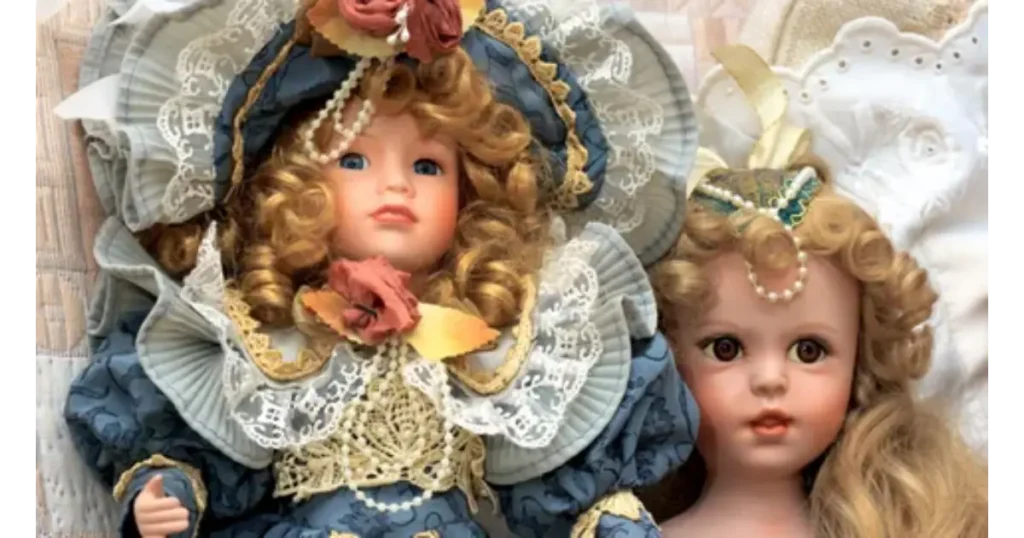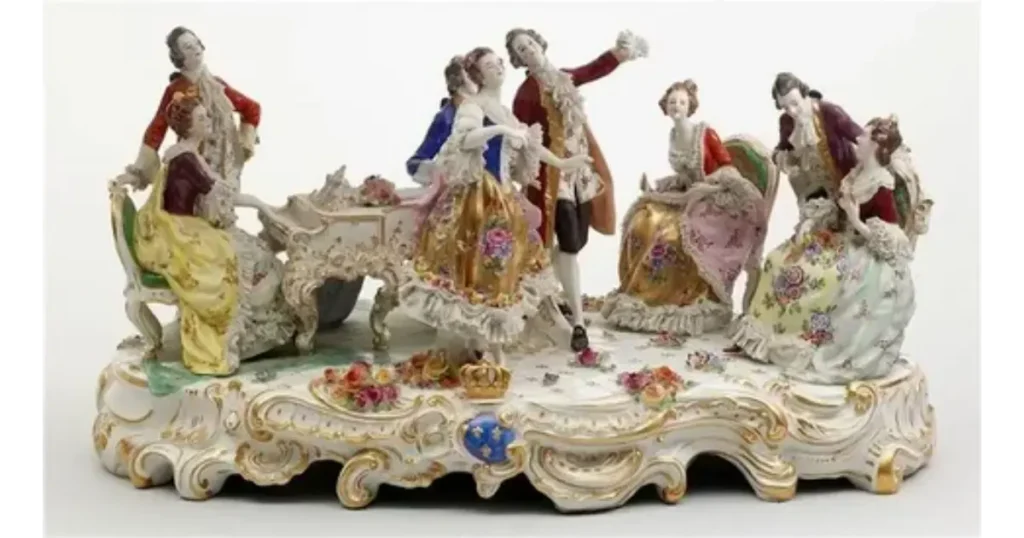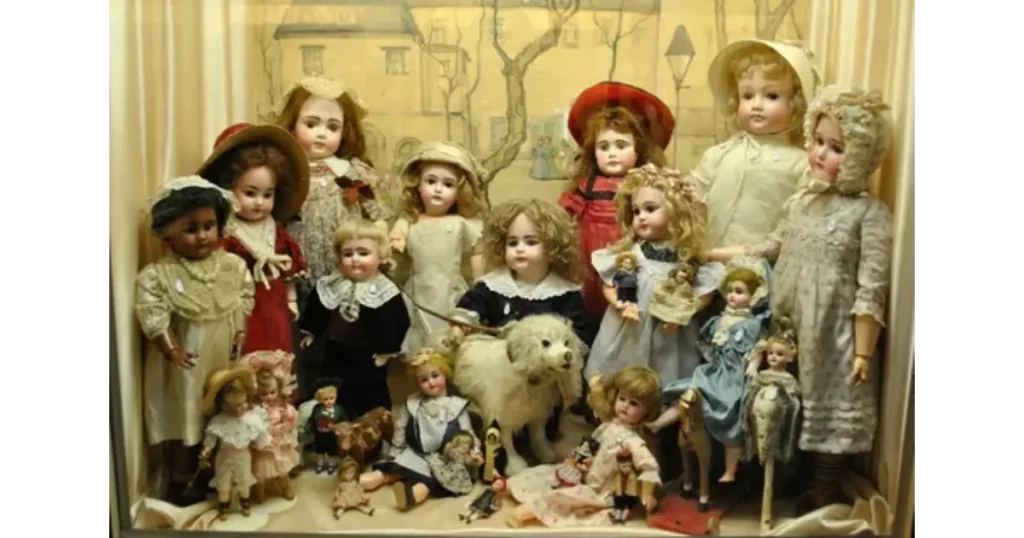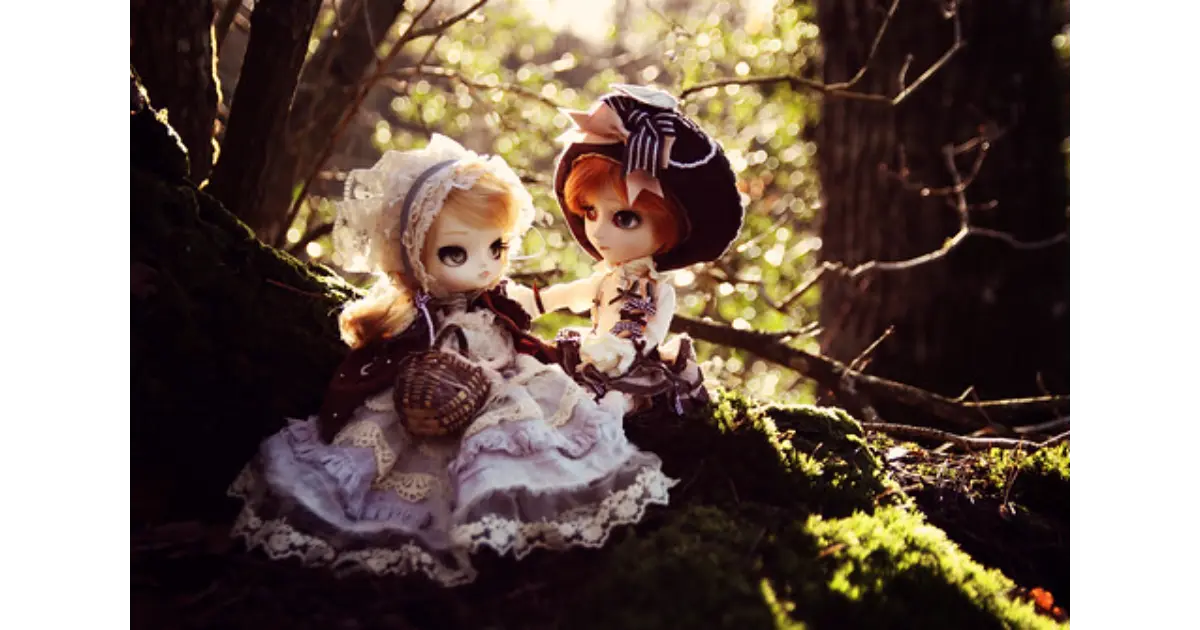For decades, porcelain dolls—with their delicate features and complex designs—have enthralled collectors and enthusiasts. Initially from Europe in the 19th century, these dolls—often created from fine china or bisque—are known for their lifelike and highly painted facial features. This book explores the fascinating history of porcelain dolls, following their development from luxury objects for the privileged to treasured collectors all around. We will examine how changes in cultural and economic environments have affected doll designs and production methods, stressing important eras and well-known producers who helped to define the porcelain doll market.
Maintaining the beauty and worth of porcelain dolls calls for specific knowledge and skills for care. The delicate porcelain is preserved, and environmental elements, including light, temperature, and humidity, considerably stop deterioration. Advice on handling techniques, appropriate cleaning chemicals, and ideal storage conditions to prevent joint problems such as cracking, crazing, and paint fading is given in this part, together with practical ideas on cleaning and preserving porcelain dolls. We also advise restoring vintage dolls so that fans can return their beloved items to their former splendour.
Knowing the present market for porcelain dolls is essential for collectors wishing to start or grow their collection in 2024. From historic choices to modern masterpieces, this guide will show the finest collections to think about and where to find them. We will review leading auction houses, internet sites, and specialist retailers providing distinctive and superior dolls. This guide seeks to provide insightful analysis on assessing authenticity and worth for both experienced collectors and new enthusiasts so that you can make wise judgments in the active world of porcelain doll collecting.
1. An Introduction to Porcelain Dolls: An Evolution Through Time
More than just toys, porcelain dolls are relics from cultural history created with extraordinary talent and attention to detail. Originally appearing in Europe in the 19th century, these dolls soon began to represent artistry and status. Originally designed for the rich children’s collection, they have become extremely sought-after collector’s goods over the years. Porcelain dolls’ voyage across time reveals much about the variations in artistic methods and society’s tastes.
Made from glazed or unglazed porcelain, these beautiful figures captivate collectors and enthusiasts with their delicate, lifelike details. Making porcelain dolls requires painstaking workmanship, from painting and dressing to sculpting and moulding. Every doll has its unique narrative, reflecting the fashion, society, and creative expression of its time. This introduction prepares one to investigate their rich history, care requirements, and modern dynamic collecting scene.
2. From 1800s Europe to Today: The History of Porcelain Doll Making

In the early 1800s, European porcelain doll makers started their work mostly in Germany and France, where the first porcelain heads were produced. Early dolls were distinguished by their glass eyes and elaborate features, created by expert artists. The processes utilised in the production of these dolls evolved along with their increasing popularity, producing new ideas in porcelain mixing and firing techniques. Porcelain dolls first emerged as not only toys but also works of exquisite art throughout this age.
By the late 19th century, porcelain doll manufacture had expanded across Europe and to the United States, where several designs and techniques started to blossom. Unlike the more adult-like features typical in European designs, American porcelain dolls from this age frequently had more infantile and expressive expressions. These variations draw attention to the regional tastes and cultural inspirations that have moulded porcelain doll manufacture from its beginnings to the present.
3. Main Historical Porcelain Doll Manufacturers
The essential historical producers are J.D. Kestner, Simon & Halbig, and Armand Marseille. Renowned for their inventiveness and quality of porcelain dolls, these German businesses were active in the late 19th and early 20th centuries. Celebrated for producing bisque dolls, which included unglazed porcelain more closely resembling skin, J.D. Kestner, sometimes known as the “King of Dollmakers,” was praised for designing dolls with extraordinarily expressive features.
Manufacturers like Jumeau and Bru Jeune created dolls with intricate silk gowns and realistic expressions that would have been the height of luxury in France. These dolls were quite valuable then and are still some of the most sought-after antiques today. Collectors sometimes hunt down these specific brands for their historical significance and exceptional artistry—which has set the doll-making benchmark for over a century.
4. The Changing Porcelain Doll Styles Over the Centuries
Since their introduction, the design of porcelain dolls has changed dramatically to reflect more significant developments in fashion and society. Designed initially as miniatures reflecting the newest adult trends, dolls were dressed in modern styles. Dollmakers started experimenting with various designs, from the extravagant Victorian gowns of the 19th century to the flapper clothing of the 1920s, capturing the evolving trends of every era as time went on.
Their clothes, as do the features and forms employed to produce the dolls, reflect this development. Early dolls had more sombre expressions and typically adult-like looks; later versions had more childlike traits and brighter expressions. This transformation captures changes in aesthetic tastes and society’s perceptions of childhood and beauty. Knowing these changes enables collectors and fans to value the artistic development and historical background included in every doll.
5. Important Maintenance Advice: Keeping Your Porcelain Dolls Looking Great

Vulnerable to environmental elements, including light, humidity, and temperature swings, Porcelain dolls must be kept beautiful and intact with proper care and maintenance. These dolls should be displayed and kept under conditions that resemble a regulated museum environment—away from direct sunlight, in rooms with steady temperature, and with a modest humidity. This helps to prevent the materials from fading or degrading and the porcelain from breaking or crazing.
Apart from environmental control, frequent light cleaning is essential to keep dolls in a perfect state. With a gentle, clean brush, gently sweep dust; gently use a moist cloth to gently remove fingerprints or other blemishes on the porcelain. Avoid abrasive objects or strong chemicals to preserve the fragile painted details and finishes. Following these cleaning rules will help collectors ensure their porcelain dolls stay brilliant and unbroken for the next generations to enjoy.
6: Safely Clean and Maintain Porcelain Dolls
Safely cleaning porcelain dolls requires only a few careful steps to guarantee their delicate characteristics remain unharmed. Start by taking off any accessories or clothes; depending on the fabric type, these should be cleaned separately. Gently brush the porcelain pieces to dry the surface dust off them. A somewhat moistened cloth with distilled water can be used for more persistent grime; avoid wetting any of the doll’s textile body or adhesive joints.
A mild soap solution can be used with a soft cloth for deeper cleaning—especially for dolls that have acquired filth over decades—and then a complete drying with a lint-free towel. The doll should not be soaked in water since this will weaken adhesives and destroy the material. When in doubt, especially about highly costly or antique dolls, always seek advice from a competent restorer to apply appropriate handling and care methods.
7. Restoring Methods for Antique Dolls Made of Porcelain

Restoring ancient porcelain dolls is a delicate craft that requires accuracy and knowledge of the materials used in their original manufacture. Doll restorers can handle problems such as cracked porcelain, missing limbs, or worn-out facial features. They employ various procedures, including colour-matched paints to repaint missing details, specialised porcelain fillers to fix cracks, and, wherever feasible, replacing ancient pieces with suitable reproductions or retaining original materials.
Conservation instead of complete restoration could be advised for collectors who want their dolls as original as feasible. This method emphasises stabilising and cleaning the dolls without changing their historical authenticity. Methods call for mild cleaning, using conservation-grade adhesives to stabilise loose components, and occasionally building special supports for display to stop additional stress on the doll’s frame.
Read Also;
8. Recognising and Appreciating Porcelain Dolls: What Collectors Need to Know
Effective identification and value of porcelain dolls depend on understanding their marks, materials, and production historical background. Usually located on the back of the head or neck, most antique porcelain dolls have the manufacturer’s logo, mould numbers, or artist’s autographs marking them. These marks can reveal vital details on the doll’s age, source, and occasionally even the model or creator.
Apart from knowing marks, knowing the usual traits of particular makers and eras will enable one to evaluate the value of a doll fairly. One crucial consideration is condition; dolls in perfect shape with original clothes and accessories usually sell for more. Visiting antique stores, going to auctions, and speaking with professionals can also provide information on the present market and assist collectors in making wise buying or selling choices.
9. Where in 2024 Should One Search for the Greatest Porcelain Doll Collections
Collectors searching for the top porcelain doll collections in 2024 will have various tools. Rare and beautiful dolls of several ages abound in auction houses like Sotheby’s and Christie’s, which presents chances to find one-of-a-kind items. From ancient to modern limited editions, online markets like eBay and Etsy also offer access to a vast array of dolls, therefore serving all levels of collectors.
Specialist doll stores and shows are also rather valuable for collectors. These locations offer dolls and an opportunity to meet other aficionados and professionals who might share knowledge and guidance. Joining collector clubs and internet forums can provide advice about forthcoming sales and hidden treasures in private collections for individuals particularly interested in particular kinds of eras of dolls.
10. Next Future Trends in Porcelain Doll Collecting

Looking ahead to porcelain doll collecting, several trends seem destined to influence the pastime. The growing interest in historically relevant and diverse dolls reflects a more significant societal movement towards these values. Driven by demand for dolls from non-Western nations or those communicating a cultural tale, collectors look for dolls that reflect several ethnic backgrounds and eras.
Furthermore, technological developments are impacting collection patterns. Using new materials and 3D printing could result in new kinds of porcelain dolls that combine modern technology with traditional workmanship, therefore providing fresh looks and maybe interactive elements. These patterns are expected to persist as the community of collectors expands and becomes more diverse, sustaining the enthusiasm for porcelain dolls.
FAQs
1. A porcelain doll is what?
A porcelain doll is either partially or totally composed of porcelain. Usually distinguished by a glazed or unglazed ceramic finish, it is known for its delicate features. These dolls are often gathered for their aesthetic and historical significance.
2. From what age and source should I find a porcelain doll?
Examining a porcelain doll’s marks—usually on the rear of the head, neck, or lower back—you can determine its age and origin. Along with perhaps the artist’s initials, these marks could include the manufacturer’s name and year of creation; additionally helpful in finding and dating porcelain dolls is consulting reference books or online databases.
3. How might porcelain dolls be presented most elegantly?
The ideal place to show porcelain dolls is in a regulated setting, free from direct sunlight, high humidity, or severe temperature. To prevent dust and physical damage, use strong shelves or display cases, including protective glass. Make sure the dolls are set firmly to prevent falls.
4. How often ought I to give my porcelain dolls a cleaning?
Porcelain dolls should be gently dusted every few months using a microfiber cloth or gentle brush. Particularly if the dolls have detailed painting or clothes, it should be done as needed and with great care for complete cleaning.
5. Can I fix damaged porcelain dolls just at home?
Minor repairs, like re-attaching loose items with appropriate adhesives, could be done at home. However, for significant damages, like cracked or missing porcelain pieces, it’s essential to see a professional restorer specialising in antique dolls to maintain their value and appearance.
6. Where may I locate worthwhile porcelain dolls to add to my collection?
Valuable porcelain dolls abound in antique stores, internet auction sites, estate sales, and specialist doll stores. Attending collector events and combining doll collector clubs can offer leads and connections for rare and valuable doll acquisition.
7. In what ways may a porcelain doll’s worth vary?
The condition, rareness, age, manufacturer, and historical relevance of a porcelain doll affect its value. Good values typically come from dolls in great shape with original clothes and accessories. Furthermore, its provenance dramatically influences the market value of the doll.
8. Should one collect porcelain dolls? Are any insurance issues relevant?
Indeed, if you have a substantial collection, you should consider insuring your dolls. A trained appraiser will evaluate them, and you can then discuss coverage for loss, damage, or theft with an insurance professional focused on collectables.
9. How may I find further information on porcelain doll history?
Reading specialised literature, visiting doll museums, and consulting reliable internet resources will help you discover more about the background of porcelain dolls. Many collector groups and internet forums also publish thorough pieces and debates on the background of several kinds of dolls.
10. What directions do porcelain doll collecting seem to be headed?
Future trends in porcelain doll collections might reflect a growing passion for dolls from many cultural backgrounds and those honouring historical personalities. New production processes brought by technological developments could also improve the quality and intricacy of contemporary porcelain dolls.
Conclusion
The world of porcelain dolls presents a remarkable window into the junction of art, history, and artistry. From their beginnings in 19th-century Europe to their current status as precious objects, porcelain dolls have always maintained a particular place in the hearts of collectors and enthusiasts. From knowledge of their background and identifying significant pieces to mastery in care and preservation, this guide has addressed the critical elements of porcelain doll collecting. Whether you are a novice collector or an experienced one, the material here seeks to enhance your collecting experience and enable you to value these timeless gems’ delicate beauty and cultural relevance. Watch developing trends as you enter 2024 and keep interacting with the community of collectors to exchange information and expertise. The stories porcelain dolls tell, and the connections they engender provide more value than just the objects themselves.








